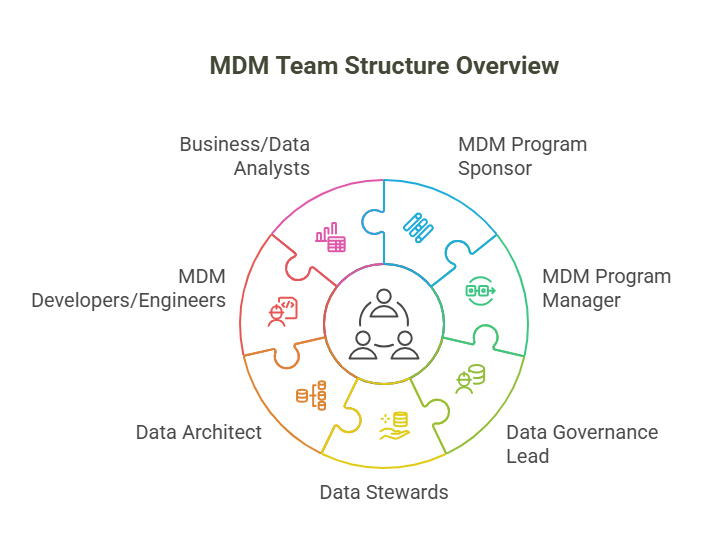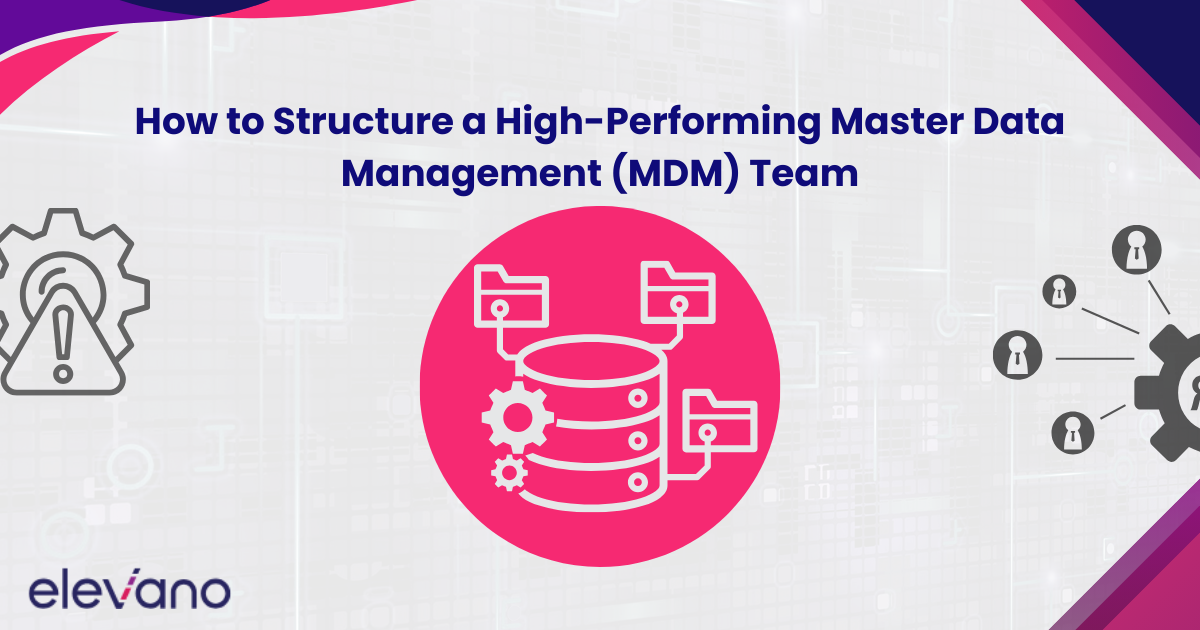Master Data Management (MDM) keeps business-critical data consistent across systems. That includes customer names, product details, and supplier records—data that supports daily operations and decision-making.
But tools and strategies alone don’t make MDM work. Team structure does. Without clear roles, ownership breaks down, accountability slips, and bad data spreads. The right people in the right roles keep MDM efforts focused, efficient, and aligned with business goals.
This guide explains how to build a strong MDM team. You’ll learn which roles matter most, how to organize the team, and how to scale it as your company grows. Let’s begin by defining MDM and why your team’s setup matters from day one.
What Is Master Data Management (MDM) and Why Team Structure Matters
Master Data Management is the process of organizing and maintaining consistent, accurate data across departments and systems. It focuses on core entities like customers, products, suppliers, and locations—data that’s used in multiple places across a business.
When this data isn’t aligned, systems don’t sync, reports are wrong, and teams waste time fixing issues manually. MDM solves that by creating a single, trusted source of truth.
But the process doesn’t run itself. That’s where team structure comes in.
Without clear roles, MDM becomes everyone’s job—and no one’s responsibility. Business teams may own the data but lack the tools. IT might have the systems but not the context. When responsibilities aren’t defined, problems get passed around instead of solved.
A solid team structure creates accountability. It ensures there are people to manage, maintain, and improve your data, not just build systems and hope they work.
Now that we’ve covered the basics, let’s break down the key roles every MDM team needs.
Core Roles in an MDM Team Structure
A strong MDM program depends on clearly defined roles. Each person plays a specific part in making sure data stays accurate, trusted, and usable across the business. Below are the core roles you need—and what each is responsible for.
1. MDM Program Sponsor
Usually a senior executive, this person secures funding, sets strategic priorities, and keeps MDM aligned with company goals. Without this backing, MDM efforts often stall or get sidelined.
2. MDM Program Manager
This role oversees the day-to-day delivery of the MDM program. They manage timelines, coordinate across departments, and make sure tasks move forward. They’re the link between business, IT, and leadership.
3. Data Governance Lead
The governance lead defines data standards, quality rules, and policies. They create the framework that keeps everyone working consistently. This person also helps settle conflicts when data ownership is shared.
4. Data Stewards
Stewards maintain and validate master data within their assigned domains—like customer, product, or vendor data. They fix errors, review changes, and work with teams to keep data clean and up to date.
5. Data Architect
The architect designs how master data moves through systems. They plan integrations, choose tools, and make sure the setup supports current needs and future growth.
6. MDM Developers / Engineers
This team builds and maintains the technical side of MDM. They write rules, configure platforms, and make sure data pipelines run smoothly. They also fix bugs and help roll out new features.
7. Business/Data Analysts
Analysts help define business needs and translate them into data rules or system updates. They track how data is used, measure improvements, and flag issues early.
Each of these roles has a clear purpose. Together, they keep MDM efforts aligned, measurable, and repeatable.

Next, let’s look at how to organize these roles into a working structure that fits your business.
How to Organize the MDM Team: Centralized vs. Federated vs. Hybrid
Once the core roles are defined, the next step is figuring out how to organize them. The structure you choose affects how quickly issues are resolved, how data rules are enforced, and how well teams work together. There’s no one-size-fits-all model, but here are three common approaches:
1. Centralized Team Structure
In this model, a single team owns the entire MDM program—strategy, governance, stewardship, and execution. All key roles report into one unit, often under IT or data governance.
Best for:
- Small to mid-sized companies
- Early-stage MDM programs
- Companies needing strong control and consistency
Pros:
- Clear ownership
- Easier to enforce standards
- Faster decision-making within the team
Cons:
- Can feel disconnected from business units
- May struggle with adoption in large organizations
2. Federated Team Structure
Here, MDM roles are spread across business units. Each department handles its own data stewardship with shared oversight from a central governance group.
Best for:
- Large enterprises with complex business units
- Companies with strong local ownership of data
Pros:
- Higher engagement from departments
- Local experts handle domain-specific data
- Better alignment with business needs
Cons:
- Inconsistent standards without strong coordination
- Slower to align on company-wide changes
3. Hybrid Team Structure
The hybrid model combines both. A central team sets strategy, standards, and governance. Local teams handle stewardship and execution with shared responsibility.
Best for:
- Companies scaling MDM across multiple regions or divisions
- Teams needing flexibility without losing consistency
Pros:
- Balanced control and flexibility
- Easier to scale and adapt
- Encourages shared responsibility
Cons:
- Requires clear roles and strong communication
- Takes more effort to manage alignment
Choosing the right structure depends on your company size, maturity, and how your data is used. With the setup in place, the next step is building the right team, starting with the skills and responsibilities that matter most.
Key Considerations for Building an MDM Team
Creating the right MDM team is more than hiring technical talent. It’s about finding people who can work across departments, make data decisions, and drive adoption. Below are the most important things to get right.
Skill Sets That Matter
MDM needs a mix of business knowledge and technical ability. Look for team members who:
- Understand how different departments use data
- Can work with both IT and business users
- Are comfortable with MDM tools and data quality platforms
- Communicate clearly and solve problems without drama
The best MDM team members are curious, organized, and consistent, not just technical.
Defining Ownership and Accountability
Without clear ownership, data problems fall through the cracks. Assign responsibility by domain—like customer, product, or location. Each domain should have:
- A data steward to handle day-to-day quality
- A business owner sets rules and priorities
- A governance leads to enforcing standards
Make it clear who approves changes, who reports issues, and who keeps things moving.
Cross-Functional Collaboration
MDM only works if business and IT stay aligned. Set up regular check-ins with stakeholders from different departments. Create a shared backlog of data issues and track progress together.
Encourage open feedback so teams feel involved, not dictated to. Good communication prevents bottlenecks and builds long-term support.
Scaling the MDM Team Over Time
Your MDM team doesn’t need to be big from day one. It should grow as your data needs grow. Here’s how to scale your team in three simple stages:
Phase 1: Startup or Early Stage
In the beginning, keep it lean. You only need a small core team, usually:
- One MDM program manager
- One or two data stewards focused on high-impact domains
- Support from IT for integration or setup
Start with one domain (like customer or product data) and manual processes. The goal here is to prove value and build early momentum.
Phase 2: Mid-Size or Scaling Stage
As adoption grows, expand the team and introduce automation. Add:
- Domain-specific data stewards
- A data analyst to track quality and usage
- A governance leads to writing and enforcing rules
Begin connecting MDM to more systems like ERP, CRM, or BI tools. Also, start setting up a regular data council or steering committee to align decisions across teams.
Phase 3: Enterprise-Level MDM
At scale, the MDM team becomes part of your company’s core infrastructure. Now you’ll need:
- A full-time architect for system design
- Dedicated MDM engineers for platform support
- A broader governance team and business analysts
- Regular audits, automated quality checks, and dashboards
The focus shifts from fixing data to keeping it clean and reliable across all business units.
As your data grows, your team should grow with it—deliberately, not reactively.
Common Mistakes in MDM Team Design (And How to Avoid Them)
Even with the right intentions, MDM programs often struggle due to poor team design. Here are some of the most frequent mistakes companies make—and how to fix them before they cost you time and trust.
1. Assigning Ownership Only to IT
MDM isn’t just a technical project. If the business doesn’t help define the data, rules will always be off. Involve business users early and give them a real say in how data is defined, approved, and maintained.
2. Skipping Executive Support
Without a sponsor at the top, MDM often lacks visibility and funding. Teams lose direction, and priorities get ignored. Always secure leadership support before scaling or making major changes.
3. Putting Tools Before People
Too many teams start by buying software instead of building the right structure. Tools help, but they won’t fix ownership gaps or unclear rules. Focus on roles, process, and accountability first, then invest in platforms.
4. Ignoring Change Management
Changing how people handle data takes time. If you roll out MDM without training or communication, adoption will be slow, or worse, people will ignore it. Always explain the “why” behind the work.
5. Not Updating the Team as You Grow
What works for a small setup won’t work at scale. Roles, rules, and workflows need to evolve with the business. Review your structure regularly and adjust where needed.
Conclusion
Building a high-performing MDM team isn’t about hiring more people—it’s about building the right system of accountability, communication, and ownership. A strong structure doesn’t just support clean data. It helps teams move faster, make better decisions, and reduce friction between business and IT.
If you’re leading MDM at your company, start by evaluating your current setup. Do roles overlap? Are stewards empowered to act? Is your team reactive or proactive? You don’t need a large team—you need a functional one that knows its purpose.
And remember, MDM isn’t a one-time project. As your business grows, your data grows with it. That means your team structure needs to keep up. Revisit it regularly, realign your goals, and stay close to the people using the data every day.
A well-structured MDM team won’t just fix data issues. It will prevent them from happening in the first place. That’s what makes the difference between just managing data and mastering it.




